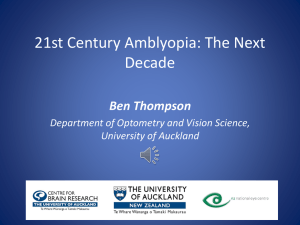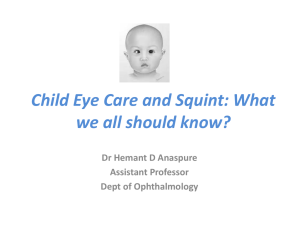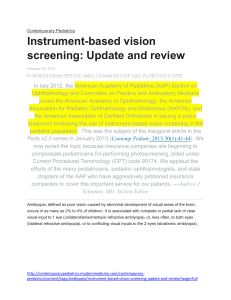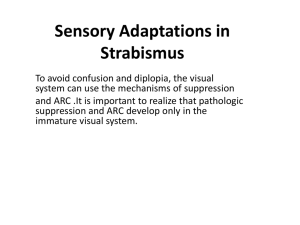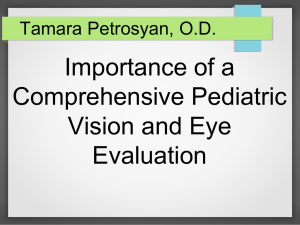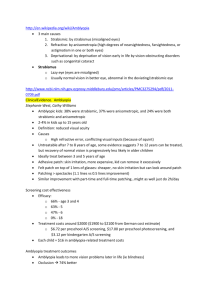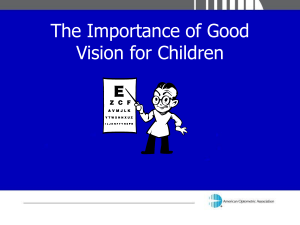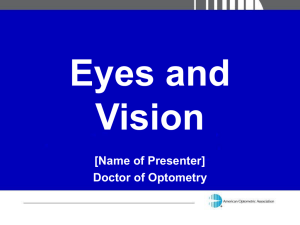AMBLYOPIA - Treatment efficiency principles
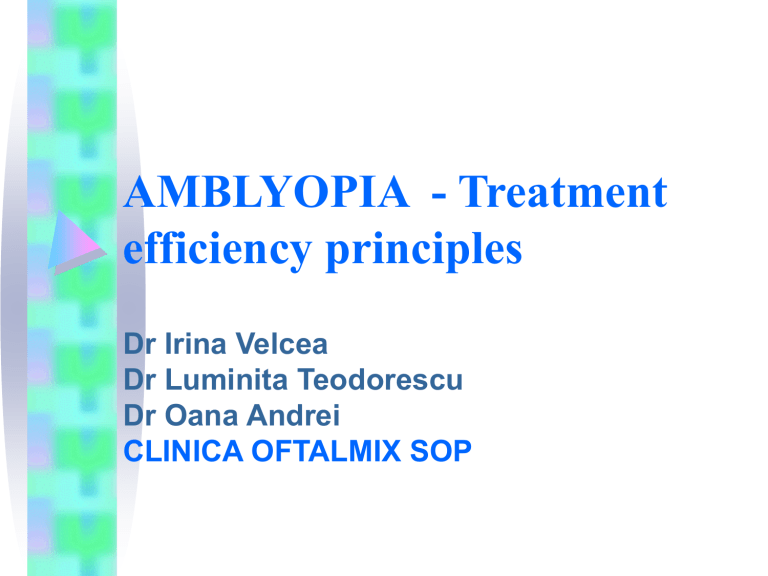
AMBLYOPIA - Treatment efficiency principles
Dr Irina Velcea
Dr Luminita Teodorescu
Dr Oana Andrei
CLINICA OFTALMIX SOP
Definition
• Decrease of vision, either unilaterally or bilaterally, for which no cause can be found by physical examination of the eye.
• Types of amblyopia:- anisometropic
- strabismic
- combined
Acuity levels for diagnosis
• a 2-line of difference on an acuity chart
• Classification: - mild: VA > 0,3
- moderate: VA= 0,1- 0,3
- severe: VA< 0,1
Principles of treatment
• Comprehensive ophthalmic examination
• Appropriate glasses prescription as initial treatment
• Patching according to a plan
• Careful follow-up
• Treatment of strabismus
Material
and methods
• 166 patients
• Anisometropic, strabismic, combined amblyopia
• Mean follow-up 2 years ( minimum 6 months, maximum 7 years)
• Full - time occlusion or part – time occlusion ( 3-6 hours/day)
Recorded parameters
• VA at the start and the end of the treatment
• Refraction
• Measurements of the deviation
• Type of occlusion
Group description
• Mean age 5 years ( minimum 1 year, maximum 11 years )
• Mean VA at the start of the treatment 0,3
( minimum 0,05, maximum 0,8 )
• Mean VA at the end of the treatment 0,7
( minimum 0,1, maximum 1 )
• Etiology:
- strabismus 47%
- anisometropia 36,7%
- mixed(strabismus+anisometropia)
16,3%
Group description
• Strabismus: esotropia 94,9% , exotropia
5,1%
• Refraction:
- hyperopic astigmatism 68,7 %
- hyperopia 26,5%
- myopic astigmatism 4,2%
- mixed astigmatism 0,6%
• Occlusion: 41% full-time, 51,2% part-time,
7,8% no occlusion
• Follow-up according to the type of occlusion and age of the child
Depth of amblyopia depending on etiology
Etiology
Strabismus
Anisometropia
Amblyopia
Severe Moderate Mild
7
3
38
31
33
27
Mixed
Total
2
12
12
81
13
73
Total
78
61
27
166
Anisometropic amblyopia
Depth of amblyopia varying with magnitude of anisometropia
Severe
Moderate
Mild
Total
Amblyopia
Anisometropia
<1 D 1-3 D >3 D
1 1 1
Total
3
15
17
33
12
7
20
4
3
8
31
27
61
Strabismic amblyopia
Depth of amblyopia depending on the type of deviation
Strabismic amblyopia
Depth of amblyopia depending on magnitude of deviation
Strabismic amblyopia
Depth of amblyopia depending on strabismus onset
Number of gained lines varying with the type of occlusion
Mean no of gained lines
Severe amblyopia
Moderate amblyopia
Full-time occlusion
Part-time occlusion
5,5
4,1
4
4,2
Mild amblyopia 3,6 2,8
Number of gained lines according to child’s age
Mean no of gained 1-3 years 3-5 years 5-8 years 8-11 years lines 4,32 3,62 2,55 3
Improvement in different types of amblyopia
Strabismic amblyopia
Anisometropic amblyopia
N
78
Minimum
0
Maximu m
9
Mean
3,35
Std.
Deviation
2,547
61 0 8 3,64 2,259
Mixed amblyopia
27 0 8 3,07 2,688
Recurrence of amblyopia
71 patients ( 42,8%) had reccurences of amblyopia, more than cited in literature (25%)
50,7% with strabismic amblyopia
- 25,3% with anisometropia
-24% with combined amblyopia
Reccurence
1-3 years 3-5 years 5-8 years 8-11 years
3,38 2,77 2,05 2,33
Improvement and recurrence of amblyopia depending by age
Conclusions
• Etiology does not influence the depth of amblyopia
• No difference in treatment response depending on etiology
• Anisometropia < 1 D cause moderate and mild amblyopia but in one case severe amblyopia.
Optical correction is essential even in small anisometropia
• In severe amblyopia, full-time is more efficient than part-time occlusion (in PEDIG studies 6 hours of patching= full-time patching)
• In moderate and mild amblyopia, the same improvement in full and part-time patching
Conclusions
• The greatest improvement is between 1-3 years of age
• First ophthalmic examination before 3 years
• Children between 8-11 years of age showed improvement of visual acuity of 3 lines with parttime occlusion, so amblyopia treatment at this age is effective
• The highest risk of recurrence is between 1-3 years of age ( follow-up according to age )
• Recurrences are more frequent in strabismic amblyopia
• Weaning before cessation of treatment reduce the chance of recurrence

